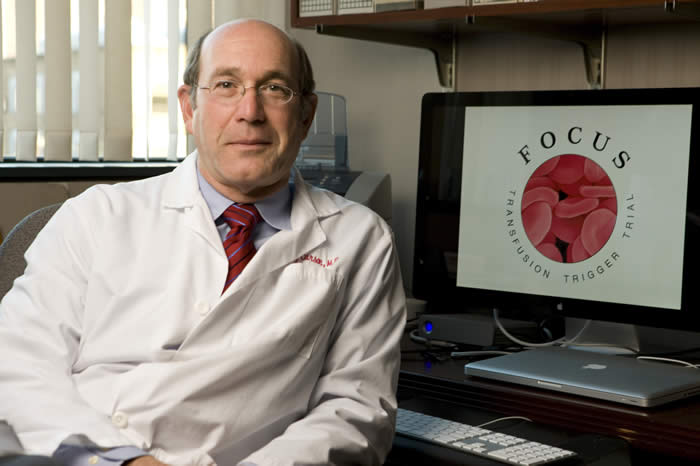CONTACT: Jennifer Forbes
732-235-6356,
jenn.forbes@umdnj.edu
Using a Restrictive Approach in Post-surgical Blood Transfusions Is Safe and Saves Blood
-- Research Published Online Today by the New England Journal of Medicine --

New Brunswick, NJ -- New research published online today in advance of print in the New England Journal of Medicine could refine the way that post-operative patients are cared for while preserving blood supply levels, an essential resource that is difficult to maintain at necessary quantities throughout the year. The study, led by researchers at UMDNJ-Robert Wood Johnson Medical School, shows that using a liberal blood transfusion strategy in post-operative hip-surgery patients did not appear to improve patients’ recoveries or reduce the rate of death, suggesting therefore, that utilizing a restrictive transfusion approach would be appropriate patient care and conserve blood.
“The need for, and the quantity of, transfusion of red blood cells in post-operative patients is controversial, but has not previously been evaluated in a large study,” said Jeffrey L. Carson, MD, the Richard C. Reynolds Professor of Medicine and study chair of the Transfusion Trigger Trial for Functional Outcomes in Cardiovascular Patients Undergoing Surgical Hip Fracture Repair, known as the FOCUS trial. “Our research shows that using a more restrictive transfusion approach could become the standard of care for post-orthopedic surgical, high-risk patients with underlying cardiovascular disease and save blood - a precious resource.”
The study examined more than 2,000 high-risk patients, with a mean age of 82, with underlying cardiovascular disease or risk factors, and hemoglobin levels below 10 grams per deciliter, after hip surgery. Hemoglobin (Hb or Hgb) is the main component of red blood cells that carries oxygen throughout the body and is normally greater than 12 to 13 grams per deciliter. Patients commonly have a low hemoglobin level after surgery that results from bleeding and often receive red blood cell transfusion as treatment. However, the optimal level of hemoglobin at which blood transfusion should be administered has been unknown.
“This clinical trial is unique in that all patients were considered very high risk due to age and prior history of cardiovascular disease, including myocardial infarction (heart attack), or risk factors for heart disease,” said Dr. Carson.
Patients were randomly assigned a liberal transfusion strategy (transfusion if hemoglobin was less than 10 grams per deciliter) or a restrictive transfusion strategy (transfusion if hemoglobin was less than 8 grams per deciliter). Patients in the restrictive group also received a transfusion if they exhibited symptoms of anemia including chest pain, congestive heart failure or unexplained excessive heart rate. At 30 and 60 days post-surgery, there was no difference between the groups in the patients’ inability to walk without assistance nor was there a significant difference in the rate of death or heart attacks. Because the liberal transfusion strategy did not provide a benefit to patient outcomes as compared with the restrictive strategy, the study suggests that less blood transfusion may be appropriate and does not detrimentally affect patients’ recovery after surgery.
The FOCUS Trial was funded by the National Heart, Lung, and Blood Institute of the National Institutes of Health. The study results, “Liberal or Restrictive Transfusion in High-risk Patients after Hip Surgery”, were published online today and can be found at: http://www.nejm.org/doi/full/10.1056/nejmoa1012452.
Dr. Carson’s team of researchers at Robert Wood Johnson Medical School included: Helaine Noveck, MPH, deputy director, Clinical Coordinating Center; George G. Rhoads, MD, MPH, interim dean and professor at UMDNJ-School of Public Health; and Karen Dragert, RN, lead research nurse. He was assisted by investigators at the University of Maryland School of Medicine (Michael L. Terrin, MD, MPH, principal investigator, Data Coordinating Center, and Jay Magaziner, PhD, MSHyg) and from 47 hospitals in the United States and Canada.
###
About UMDNJ-ROBERT WOOD JOHNSON MEDICAL SCHOOL
As one of the nation’s leading comprehensive medical schools, UMDNJ-Robert Wood Johnson Medical School is dedicated to the pursuit of excellence in education, research, health care delivery, and the promotion of community health. In cooperation with Robert Wood Johnson University Hospital, the medical school’s principal affiliate, they comprise New Jersey’s premier academic medical center. In addition, Robert Wood Johnson Medical School has 34 other hospital affiliates and ambulatory care sites throughout the region.
As one of the eight schools of the University of Medicine and Dentistry of New Jersey with 2,800 full-time and volunteer faculty, Robert Wood Johnson Medical School encompasses 22 basic science and clinical departments, hosts centers and institutes including The Cancer Institute of New Jersey, the Child Health Institute of New Jersey, the Center for Advanced Biotechnology and Medicine, the Environmental and Occupational Health Sciences Institute, and the Stem Cell Institute of New Jersey. The medical school maintains educational programs at the undergraduate, graduate and postgraduate levels for more than 1,500 students on its campuses in New Brunswick, Piscataway, and Camden, and provides continuing education courses for health care professionals and community education programs. To learn more about UMDNJ-Robert Wood Johnson Medical School, log on to rwjms.umdnj.edu. Find us online at www.Facebook.com/RWJMS and www.twitter.com/UMDNJ_RWJMS.


 Back to News Releases
Back to News Releases

